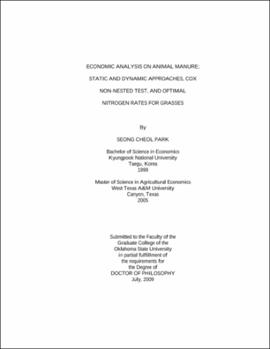| dc.contributor.advisor | Stoecker, Arthur | |
| dc.contributor.author | Park, Seong Cheol | |
| dc.date.accessioned | 2013-11-26T08:22:04Z | |
| dc.date.available | 2013-11-26T08:22:04Z | |
| dc.date.issued | 2009-07 | |
| dc.identifier.uri | https://hdl.handle.net/11244/6531 | |
| dc.description.abstract | Scope and Method of Study: This study consists of three sections. The purpose of first section is to determine an economic profitability of sustained application of swine lagoon effluent and beef feedlot manure relative to anhydrous ammonia in the Oklahoma Panhandle. Two approaches: ANOVA for a static analysis and an optimization for a dynamic analysis were obtained. The purpose of second section is to examine the fitness of two competing production functions (quadratic and logistic) to data. Misspecification tests and the Cox non-nested test with a parametric fast double bootstrap were adopted. The purpose of last section is to determine optimal nitrogen rates for each of four grasses with two nitrogen sources. The variance covariance structures of the error term with repeated measures data and the existence of systematic changes in parameters of response functions were studied. | |
| dc.description.abstract | Findings and Conclusions: For the first section, swine lagoon effluent was found to be the nitrogen source which provided the largest economic profits among three nitrogen sources (anhydrous ammonia, beef manure and swine effluent) in both approaches. A difference in optimal nitrogen rates between two approaches also indicates that the amount of nitrogen applied can be reduced significantly when the residual soil nitrogen level is considered. Animal manure can be an agronomically and economically viable substitute for commercial fertilizers. For the second section, two functional forms well represent the dry matter response of bermudagrass to total available nitrogen. A higher expected yield and profit was obtained in the logistic model than in the quadratic model. For the last section, the AR(1) variance covariance error structure was selected according to the selection criteria. The most profitable forage was bermudagrass fertilized with swine effluent. Swine effluent was a better nitrogen source that yielded higher profits than urea. The same nitrogen rate was optimal with buffalograss. A higher optimal nitrogen rate was obtained for orchardgrass rather than for wheatgrass when plots were treated with swine effluent. | |
| dc.format | application/pdf | |
| dc.language | en_US | |
| dc.rights | Copyright is held by the author who has granted the Oklahoma State University Library the non-exclusive right to share this material in its institutional repository. Contact Digital Library Services at lib-dls@okstate.edu or 405-744-9161 for the permission policy on the use, reproduction or distribution of this material. | |
| dc.title | Economic analysis on animal manure; Static and dynamic approaches, Cox non-nested test, and optimal nitrogen rates for grasses | |
| dc.contributor.committeeMember | Brorsen, B. Wade | |
| dc.contributor.committeeMember | Hattey, Jeffory A. | |
| dc.contributor.committeeMember | Boyer, Tracy Ann | |
| dc.contributor.committeeMember | Norwood, F. Bailey | |
| osu.filename | Park_okstate_0664D_10456.pdf | |
| osu.accesstype | Open Access | |
| dc.type.genre | Dissertation | |
| dc.type.material | Text | |
| thesis.degree.discipline | Agricultural Economics | |
| thesis.degree.grantor | Oklahoma State University | |
